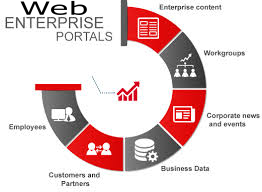Web Enterprise Portals

Web Enterprise Portals
Concept or Technology and the Emergence of Software as a Service
The term portal is widely used across the web today and means different things to different people. In general, however, there are two primary meanings for the term: portal as a software technology and portal as an abstract concept. As a concept portal refers to bringing together a wide range of tools, data, and applications into a single, personalized and interactive website. As a technology, it means a software product providing the infrastructure to create and manage an enterprise portal. To better understand why businesses purchase portal products, we need to understand what purpose a portal serves.
Components of a portal
Businesses build portals to create a centralized knowledge center that their employees, customers or business partners can use to find information, talk to other people, share information with others, and interact with backend applications. Some of the key parts in portals include:
- Security – most portals have a security component that requires people to log in. This enables a business to provide access to secure applications and content based on the security level of the user.
- All content, tools and applications are made available in a portal through windows called portlets or webparts (SharePoint). A portal is just a shell without these portlets.
- Ability to provide a personalized view based on either a registration process or pre-populated security database. In some portals we see the use of a special area called “MySite” where the user can place links to their frequently accessed tools, applications and content.
- Ability to target information based on audience profiling. In this case, the portal has views based on a set of audiences and not a particular person. An example of an audience is a management team. Special portlets can be created specifically for this audience.
- Application Integration – portlets surface other web applications directly into the portal. A user can then use the portal to access the application. This usually requires passing security credentials stored in the portal security database to the other application.
- Data Integration – many portals provide special data providers that can connect to backend databases, mainframes and applications and then expose the data from those systems into the portal via a portlet. The data can be presented in any way the user requires. This eliminates the need to go to these backend systems to get data.
- Content Management – some portals provide content management, others integrate content management systems
- Collaboration – many portals provide different collaboration technologies such as discussion groups, wikis, and online presence awareness
Portal Software Vendors
There are today no pure-play portal vendors in the market. Most software providers also sell an enterprise suite of technologies that includes content management, collaboration and single sign-on technologies. Some of the portal vendors today include:
- Microsoft
- BEA (provides 2)
- Vignette
- Oracle (provides 2)
- IBM
- JBoss (Open Source)
- Apache Project (Open Source)
These products and more are considered horizontal portal products because they pull together data and information across a business and not just a specific line of business.
Personal Start-up Pages
Although not currently a direct threat to traditional portal software now, companies like Google, Microsoft (MSN) and Yahoo provide a version of portal to consumers called a personal start-up page. These start-up pages enable a user to add “mashups” which are similar to portlets that have a range of abilities including data, applications, and content. So even though few enterprises use open source portal software today, the interest is growing and these start-up page vendors have the ability to change the competitive landscape for portal software.
Software as a service means the ability to provide software to companies across the internet. Google does this with its word processing and spreadsheet applications. They could continue this trend by selling a version of its start-up page.
There are many portal products on the market today all providing similar services. But some are better at one service than another. It’s important to fully understand a businesses requirements and strategic direction before purchasing a product.
